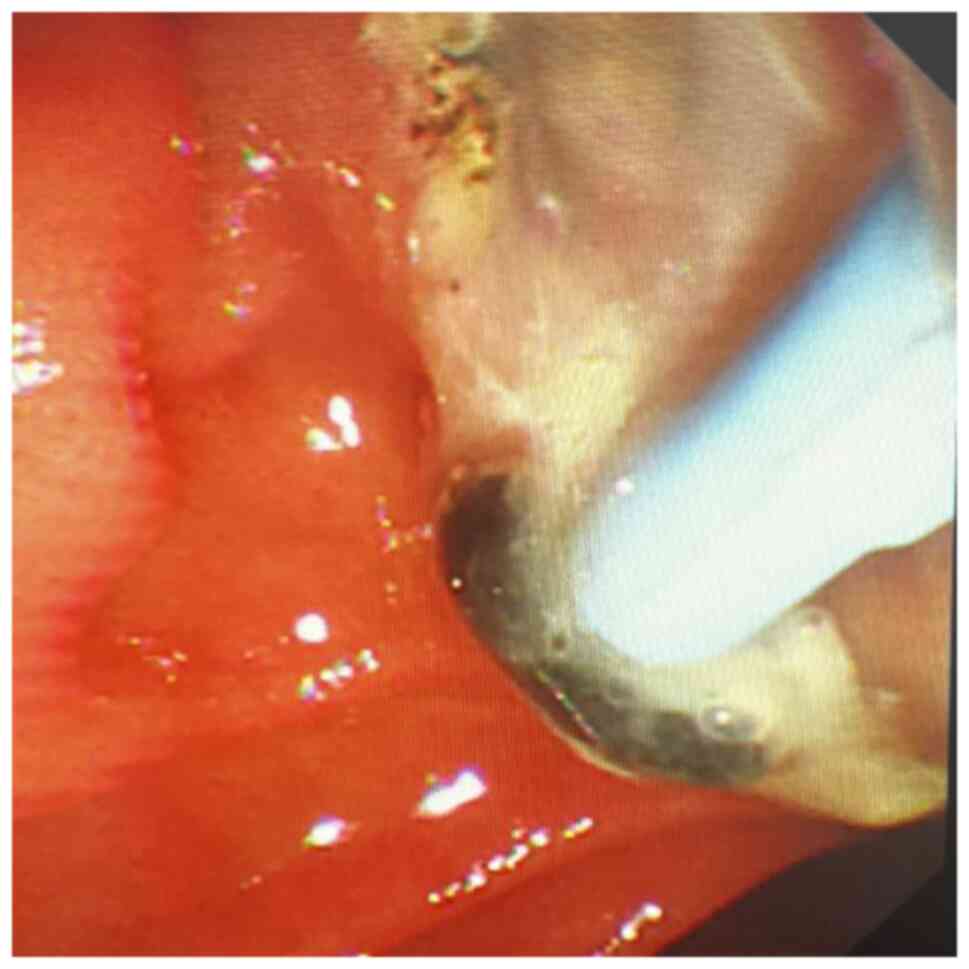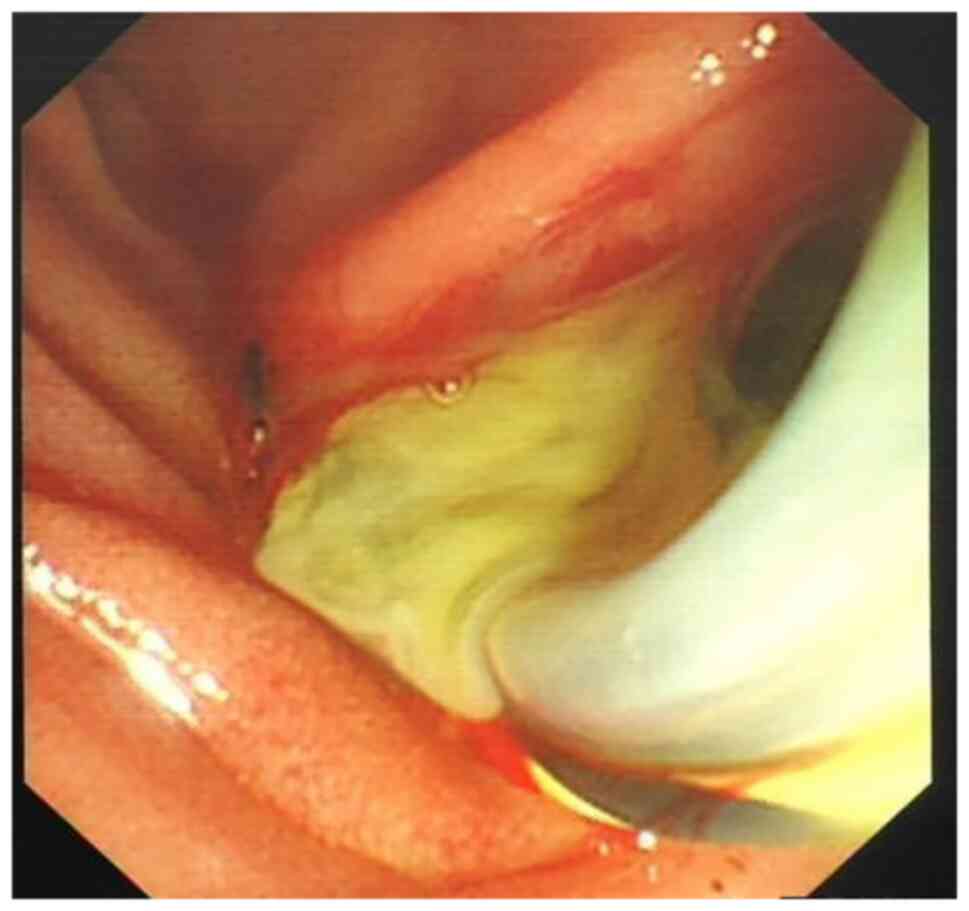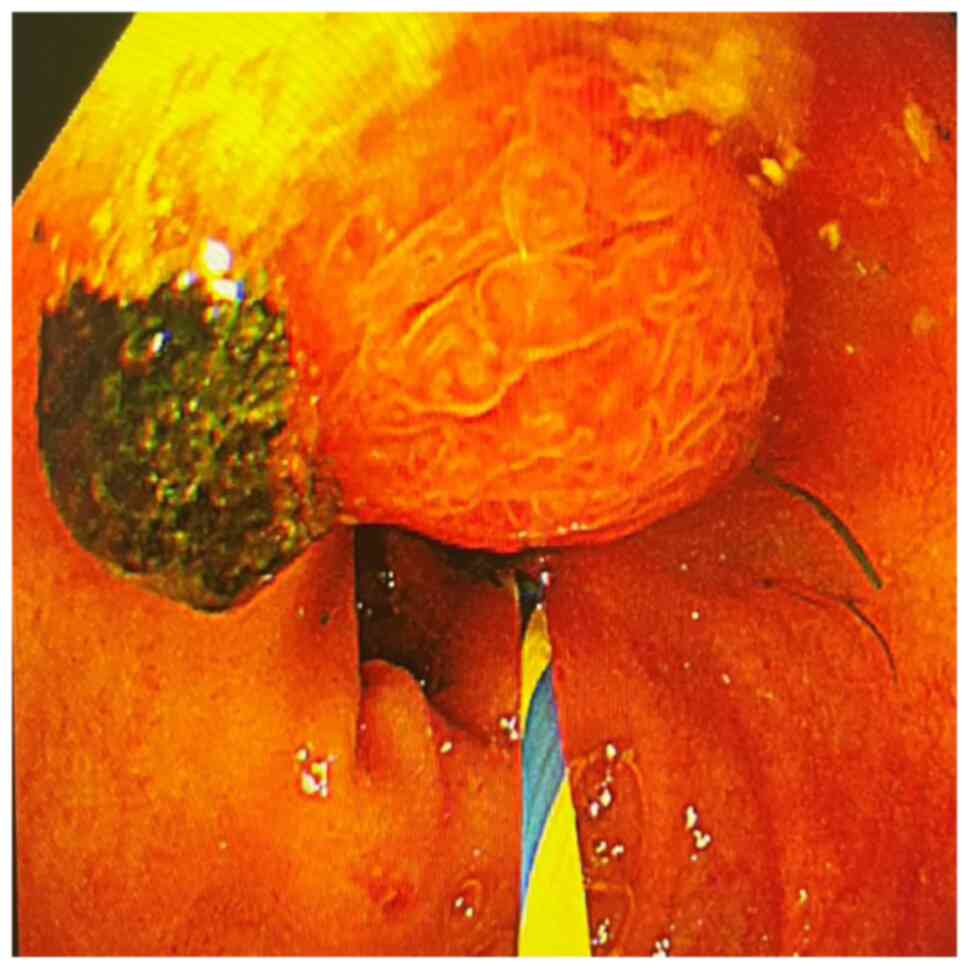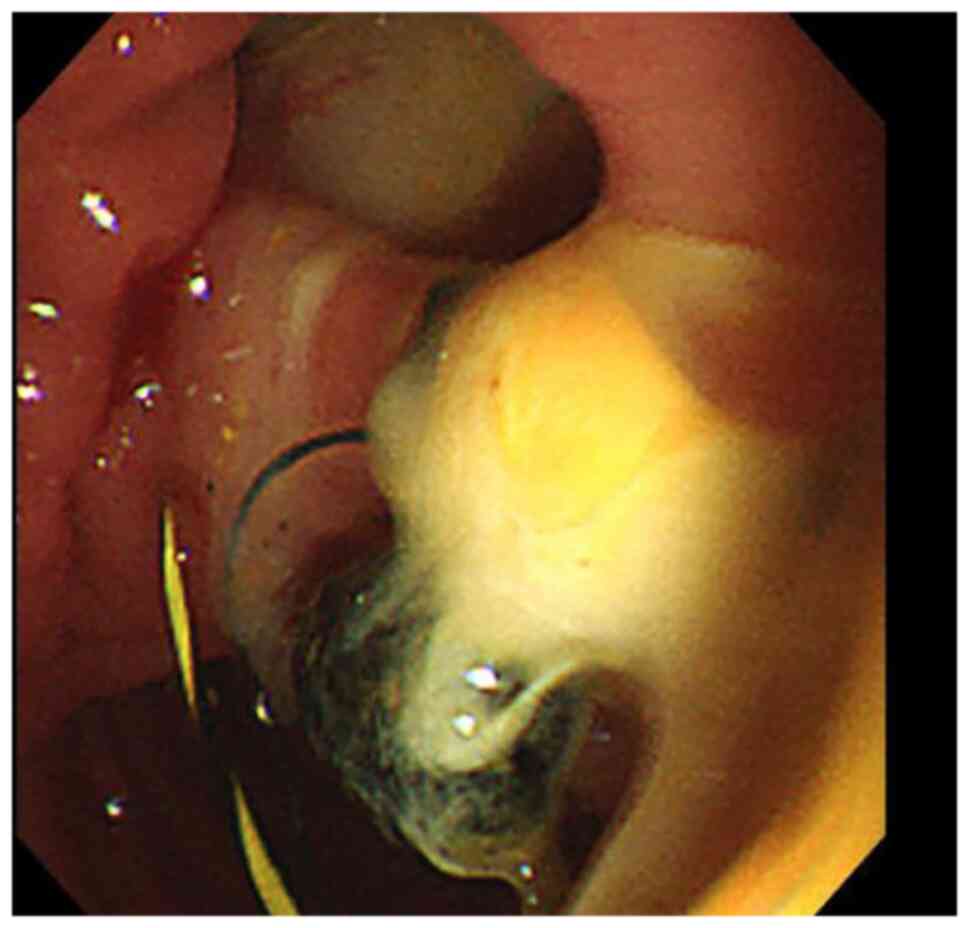|
1
|
Kiriyama S, Kozaka K, Takada T, Strasberg
SM, Pitt HA, Gabata T, Hata J, Liau KH, Miura F, Horiguchi A, et
al: Tokyo guidelines 2018: Diagnostic criteria and severity grading
of acute cholangitis (with videos). J Hepatobiliary Pancreat Sci.
25:17–30. 2018.PubMed/NCBI View
Article : Google Scholar
|
|
2
|
Meng M, Feng H, Tang S and Peng X:
Efficacy of ultrasound-guided percutaneous transhepatic biliary
drainage for acute obstructive suppurative cholangitis combined
with septic shock. Clinics (Sao Paulo). 78(100258)2023.PubMed/NCBI View Article : Google Scholar
|
|
3
|
Sung JY, Costerton JW and Shaffer EA:
Defense system in the biliary tract against bacterial infection.
Dig Dis Sci. 37:689–696. 1992.PubMed/NCBI View Article : Google Scholar
|
|
4
|
Lam SK: A study of endoscopic
sphincterotomy in recurrent pyogenic cholangitis. Br J Surg.
71:262–266. 1984.PubMed/NCBI View Article : Google Scholar
|
|
5
|
Navaneethan U, Gutierrez NG, Jegadeesan R,
Venkatesh PG, Sanaka MR, Vargo JJ and Parsi MA: Factors predicting
adverse short-term outcomes in patients with acute cholangitis
undergoing ERCP: A single center experience. World J Gastrointest
Endosc. 6:74–81. 2014.PubMed/NCBI View Article : Google Scholar
|
|
6
|
Ma CL, Wang LP, Qiao S, Wang XF, Zhang X,
Sun RJ, Liu JG and Li YC: Risk factors for death of elderly
patients with acute obstructive suppurative cholangitis. West
Indian Med J. 65:316–319. 2015.PubMed/NCBI View Article : Google Scholar
|
|
7
|
Biliary Surgery Group, Surgery Branch of
Chinese Medical Association. Guidelines for diagnosis and treatment
of acute biliary tract infections (2021). Chin J Surg. 59:422–429.
2021.PubMed/NCBI View Article : Google Scholar
|
|
8
|
Hu Z, Ni P, Fan X, Men R and Yang L: Past
hepatitis B virus infection was not associated with poorer response
or the UK-PBC risk score in ursodeoxycholic acid-treated patients
with primary biliary cirrhosis. Eur J Gastroenterol Hepatol.
31(277)2019.PubMed/NCBI View Article : Google Scholar
|
|
9
|
Zhao J, Wang Q and Zhang J: Changes in
microbial profiles and antibiotic resistance patterns in patients
with biliary tract infection over a six-year period. Surg Infect
(Larchmt). 20:480–485. 2019.PubMed/NCBI View Article : Google Scholar
|
|
10
|
Chen M, Wang L, Wang Y, Wei W, Yao YL,
Ling TS, Shen YH and Zou XP: Risk factor analysis of post-ERCP
cholangitis: A single-center experience. Hepatobiliary Pancreat Dis
Int. 17:55–58. 2018.PubMed/NCBI View Article : Google Scholar
|
|
11
|
Liu Y, Zhang C, Song M, Han X and Jiao D:
Predicting early biliary infection after stenting of malignant
biliary obstruction: Model development and internal validation.
Abdom Radiol (NY). 48:2456–2465. 2023.PubMed/NCBI View Article : Google Scholar
|
|
12
|
Turk Wensveen T, Gašparini D, Rahelić D
and Wensveen FM: Type 2 diabetes and viral infection; cause and
effect of disease. Diabetes Res Clin Pract.
172(108637)2021.PubMed/NCBI View Article : Google Scholar
|
|
13
|
Cozma MA, Dobrică EC, Shah P, Shellah D,
Găman MA and Diaconu CC: Implications of type 2 diabetes mellitus
in patients with acute cholangitis: A systematic review of current
literature. Healthcare (Basel). 10(2196)2022.PubMed/NCBI View Article : Google Scholar
|
|
14
|
Tsujino T, Sugita R, Yoshida H, Yagioka H,
Kogure H, Sasaki T, Nakai Y, Sasahira N, Hirano K, Isayama H, et
al: Risk factors for acute suppurative cholangitis caused by bile
duct stones. Eur J Gastroenterol Hepatol. 19:585–588.
2007.PubMed/NCBI View Article : Google Scholar
|
|
15
|
Khozhibaev AM, Atadzhanov SK, Khakimov BB
and Khoshimov MA: Minimally invasive interventions for acute
cholecystitis complicated by mechanical jaundice in elderly and
senile patients. Vestn Khir Im I I Grek. 166:66–69. 2007.PubMed/NCBI(In Russian).
|
|
16
|
Qin YS, Li QY, Yang FC and Zheng SS: Risk
factors and incidence of acute pyogenic cholangitis. Hepatobiliar
Pancreat Dis Int. 11:650–654. 2012.PubMed/NCBI View Article : Google Scholar
|
|
17
|
Kiriyama S, Takada T, Hwang TL, Akazawa K,
Miura F, Gomi H, Mori R, Endo I, Itoi T, Yokoe M, et al: Clinical
application and verification of the TG13 diagnostic and severity
grading criteria for acute cholangitis: An international
multicenter observational study. J Hepatobiliary Pancreat Sci.
24:329–337. 2017.PubMed/NCBI View
Article : Google Scholar
|
|
18
|
Kogure H, Tsujino T, Yamamoto K, Mizuno S,
Yashima Y, Yagioka H, Kawakubo K, Sasaki T, Nakai Y, Hirano K, et
al: Fever-based antibiotic therapy for acute cholangitis following
successful endoscopic biliary drainage. J Gastroenterol.
46:1411–1417. 2011.PubMed/NCBI View Article : Google Scholar
|
|
19
|
Yıldız BD, Özden S, Saylam B, Martlı F and
Tez M: Simplified scoring system for prediction of mortality in
acute suppurative cholangitis. Kaohsiung J Med Sci. 34:415–419.
2018.PubMed/NCBI View Article : Google Scholar
|
|
20
|
Mohan R, Goh SWL, Tan G, Junnarkar SP,
Huey C and Shelat VG: Validation of TG07 and TG13/TG18 criteria for
acute cholangitis and predictors of in-hospital mortality in
patients over 80 years old. Clin Exp Hepatol. 7:396–405.
2021.PubMed/NCBI View Article : Google Scholar
|
|
21
|
Yin M, Si L, Qin W, Li C, Zhang J, Yang H,
Han H, Zhang F, Ding S, Zhou M, et al: Predictive value of serum
albumin level for the prognosis of severe sepsis without exogenous
human albumin administration: A prospective cohort study. J
Intensive Care Med. 33:687–694. 2018.PubMed/NCBI View Article : Google Scholar
|
|
22
|
Schneider J, Hapfelmeier A, Thöres S,
Obermeier A, Schulz C, Pförringer D, Nennstiel S, Spinner C, Schmid
RM, Algül H, et al: Mortality risk for acute cholangitis (MAC): A
risk prediction model for in-hospital mortality in patients with
acute cholangitis. BMC Gastroenterol. 16(15)2016.PubMed/NCBI View Article : Google Scholar
|
|
23
|
Gravito-Soares E, Gravito-Soares M, Gomes
D, Almeida N and Tomé L: Clinical applicability of Tokyo guidelines
2018/2013 in diagnosis and severity evaluation of acute cholangitis
and determination of a new severity model. Scand J Gastroenterol.
53:329–334. 2018.PubMed/NCBI View Article : Google Scholar
|
|
24
|
Kaur M, Chandel K, Reddy P, Gupta P,
Samanta J, Mandavdhare H, Sharma V, Singh H, Naseem S, Sinha SK, et
al: Neutrophil-lymphocyte ratio predicts clinical response to
percutaneous transhepatic biliary drainage in acute cholangitis. J
Clin Exp Hepatol. 13:390–396. 2023.PubMed/NCBI View Article : Google Scholar
|
|
25
|
Liu Y, Sun J, Zhang Q, Jin B, Zhu M and
Zhang Z: Identification of bile survivin and carbohydrate antigen
199 in distinguishing cholangiocarcinoma from benign obstructive
jaundice. Biomark Med. 11:11–18. 2017.PubMed/NCBI View Article : Google Scholar
|
|
26
|
Minaga K, Kitano M, Imai H, Yamao K,
Kamata K, Miyata T, Omoto S, Kadosaka K, Yoshikawa T and Kudo M:
Urgent endoscopic ultrasound-guided choledochoduodenostomy for
acute obstructive suppurative cholangitis-induced sepsis. World J
Gastroenterol. 22:4264–4269. 2016.PubMed/NCBI View Article : Google Scholar
|
|
27
|
Kinney TP: Management of ascending
cholangitis. Gastrointest Endosc Clin N Am. 17:289–306.
2007.PubMed/NCBI View Article : Google Scholar
|
|
28
|
Leung JW: Does the addition of endoscopic
sphincterotomy to stent insertion improve drainage of the bile duct
in acute suppurative cholangitis? Gastrointest Endosc. 58:570–572.
2003.PubMed/NCBI View Article : Google Scholar
|
|
29
|
Kajbafzadeh AM, Keihani S, Kameli SM and
Hojjat A: Maternal urinary carbohydrate antigen 19-9 as a novel
biomarker for evaluating fetal hydronephrosis: A pilot study.
Urology. 101:90–93. 2017.PubMed/NCBI View Article : Google Scholar
|
|
30
|
Shinya S, Sasaki T, Yamashita Y, Kato D,
Yamashita K, Nakashima R, Yamauchi Y and Noritomi T and Noritomi T:
Procalcitonin as a useful biomarker for determining the need to
perform emergency biliary drainage in cases of acute cholangitis. J
Hepatobiliary Pancreat Sci. 21:777–785. 2014.PubMed/NCBI View
Article : Google Scholar
|
|
31
|
Umefune G, Kogure H, Hamada T, Isayama H,
Ishigaki K, Takagi K, Akiyama D, Watanabe T, Takahara N, Mizuno S,
et al: Procalcitonin is a useful biomarker to predict severe acute
cholangitis: A single-center prospective study. J Gastroenterol.
52:734–745. 2017.PubMed/NCBI View Article : Google Scholar
|
|
32
|
Song J, Park DW, Moon S, Cho HJ, Park JH,
Seok H and Choi WS: Diagnostic and prognostic value of
interleukin-6, pentraxin 3, and procalcitonin levels among sepsis
and septic shock patients: A prospective controlled study according
to the Sepsis-3 definitions. BMC Infect Dis. 19(968)2019.PubMed/NCBI View Article : Google Scholar
|
|
33
|
Zheng BH, Yang LX, Sun QM, Fan HK, Duan M,
Shi JY, Wang XY, Zhou J, Fan J, Ma ZY and Gao Q: A new preoperative
prognostic system combining CRP and CA199 for patients with
intrahepatic cholangiocarcinoma. Clin Transl Gastroenterol.
8(e118)2017.PubMed/NCBI View Article : Google Scholar
|
|
34
|
Zeng PJ, Li H, Chen YL, Pei H and Zhang L:
Serum CA199 levels are significantly increased in patients
suffering from liver, lung, and other diseases. Prog Mol Biol
Transl Sci. 162:253–264. 2019.PubMed/NCBI View Article : Google Scholar
|
|
35
|
Zhang K, Zhang L and Zheng L: Clinical
predictive value of different serological indicators for acute
cholangitis secondary to common bile duct stones. J Local Surg
Surg. 31:512–515. 2021.
|
|
36
|
Mei Y, Chen L, Peng CJ, Wang J, Zeng PF,
Wang GX, Li WP, Luo YQ, Du C, Liu K, et al: Diagnostic value of
elevated serum carbohydrate antigen 199 level in acute cholangitis
secondary to choledocholithiasis. World J Clin Cases. 6:441–466.
2018.PubMed/NCBI View Article : Google Scholar
|
|
37
|
Chen W, Wang S, Zhao H, Wang G, Qin R,
Huang F, Geng W, Liu Z, Wang W, Wu R, et al: High level of tumor
marker CA19-9 returned to normal after cholecystectomy in calculous
cholecystitis patients. Scand J Gastroenterol. 58:643–648.
2023.PubMed/NCBI View Article : Google Scholar
|
|
38
|
Khizar H, Zhicheng H, Chenyu L, Yanhua W
and Jianfeng Y: Efficacy and safety of endoscopic drainage versus
percutaneous drainage for pancreatic fluid collection; a systematic
review and meta-analysis. Ann Med. 55(2213898)2023.PubMed/NCBI View Article : Google Scholar
|


















